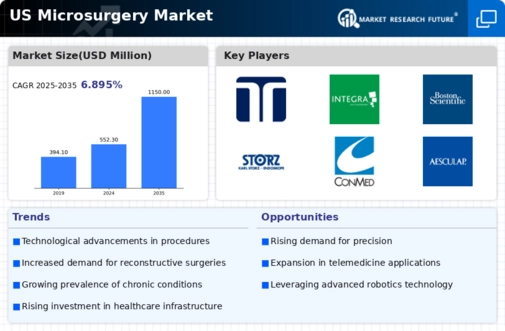The US Microsurgery Market is characterized by a dynamic landscape that reflects both the technological advancements in surgical techniques and the growing demand for minimally invasive procedures. This market has seen various competitors emerge, each striving to differentiate their offerings through innovative products, enhanced services, and strategic collaborations. The competitive environment is influenced by factors such as regulatory challenges, pricing strategies, and the capacity of firms to adapt to evolving customer needs.
As the demand for microsurgical procedures continues to rise, companies are increasingly focusing on research and development, aiming to introduce state-of-the-art solutions that enhance surgical precision and patient outcomes. The competitive insights reveal a robust market with opportunities for growth, emphasizing the importance of agility and innovation in gaining market share.
In the context of the US Microsurgery Market, Teleflex has established a notable presence by offering a wide range of specialized surgical instruments and devices aimed at enhancing clinical effectiveness. The company leverages its strong reputation in the medical device industry to deliver high-quality microsurgery solutions that meet the specific needs of healthcare professionals. Teleflex's commitment to improving surgical performance and patient safety is evidenced by its advanced product portfolio, which includes instrumentation tailored for microsurgical applications. The company's extensive distribution network and strong relationships with healthcare providers further bolster its market position, allowing Teleflex to maintain a competitive edge.
Moreover, its focus on addressing practitioner needs through continuous feedback and product innovation has positioned Teleflex favorably within the microsurgery sector.
Integra LifeSciences represents a key player in the US Microsurgery Market, known for its comprehensive range of products and services aimed at facilitating complex surgical procedures. The company specializes in advanced wound care and regenerative medicine, with a strong selection of microsurgical tools and biomaterials that enhance surgical capabilities. Integra LifeSciences' strategic investments in research and development have led to the introduction of innovative offerings such as surgical reconstruction and repair devices, contributing to its positive market trajectory.
The company's strengths lie in its ability to integrate cutting-edge technology into its products, along with a strong commitment to customer service and support. Recent mergers and acquisitions have further enhanced Integra LifeSciences' capabilities, expanding its product lines and solidifying its footprint in the US market. This aggressive growth strategy, combined with a focus on customer needs and innovation, cements Integra LifeSciences' reputation as a formidable competitor in the microsurgery field.




















